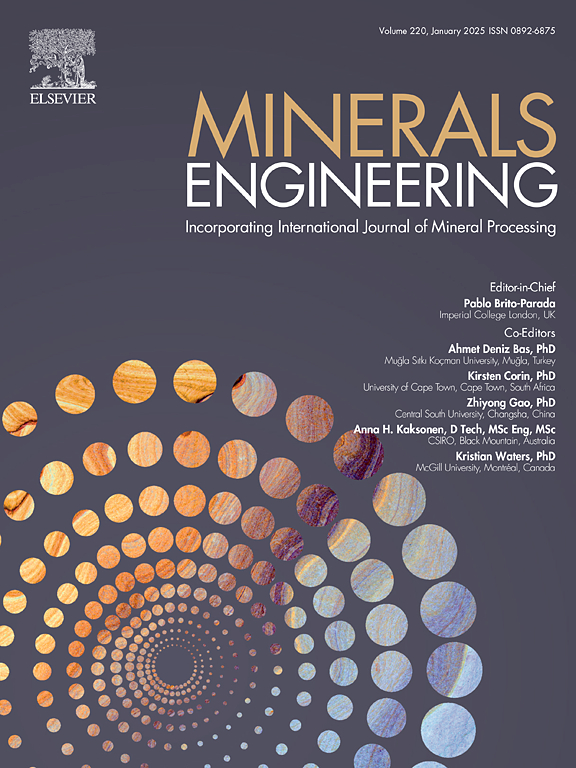Flotation separation of homogenized fluorite and calcite using sodium silicate and AlCl3 as a combined depressant
IF 4.9
2区 工程技术
Q1 ENGINEERING, CHEMICAL
引用次数: 0
Abstract
Effective flotation separation of fluorite and calcite is a critical challenge due to their comparable physicochemical characteristics and surface iso-transformation. The effects of sodium silicate (SS) and Al3+ on the flotation separation of homogenized fluorite and calcite were investigated based on flotation experiments and various measurements such as Zeta potential, scanning electron microscopy (SEM), solution chemistry, X-ray photoelectron spectroscopy (XPS), microcalorimetry. The results showed that the combination of SS and Al3+ significantly depressed calcite flotation, but only slightly affecting fluorite flotation. The surface potential of calcite was found to be increased in the presence of Al3+, enhancing the adsorption of SS. A higher affinity for the formation and adsorption of aluminum oxide on the surface of calcite compared to fluorite was indicated by SEM results, increasing the selective depression of SS on calcite. The DFT findings verified the formation of Al − O bonds upon the interaction between Al3+ and calcite. However, no Al − O bonds occurred on fluorite surface. The distinct adsorption energies were attributed to variations in the surface bonding characteristics of Al3+ with O on the calcite and F− on the fluorite. The microcalorimetry analyses revealed that the adsorption of Al3+ on calcite surface exhibited more negative adsorption enthalpy and faster adsorption kinetics, improving the adsorption of SS species on calcite surface, ultimately reducing the floatability of calcite.

硅酸钠和三氯化铝联合抑制剂浮选分离均质萤石和方解石
由于萤石和方解石具有相似的物理化学特性和表面等转化,因此有效浮选分离萤石和方解石是一个关键挑战。通过浮选实验和Zeta电位、扫描电镜(SEM)、溶液化学、x射线光电子能谱(XPS)、微量热法等测试手段,研究了硅酸钠(SS)和Al3+对均质萤石和方解石浮选分离的影响。结果表明:SS与Al3+的组合对方解石浮选有显著抑制作用,对萤石浮选影响较小;Al3+的存在增加了方解石的表面电位,增强了SS的吸附。SEM结果表明,与萤石相比,方解石表面氧化铝的形成和吸附具有更高的亲和力,增加了SS在方解石上的选择性抑制。DFT结果证实了Al3+与方解石相互作用形成Al−O键。而萤石表面未形成Al - O键。不同的吸附能归因于Al3+与方解石上O和萤石上F−的表面键合特性的变化。微量热分析表明,Al3+在方解石表面的吸附表现出更多的负吸附焓和更快的吸附动力学,从而改善了SS在方解石表面的吸附,最终降低了方解石的可浮性。
本文章由计算机程序翻译,如有差异,请以英文原文为准。
求助全文
约1分钟内获得全文
求助全文
来源期刊

Minerals Engineering
工程技术-工程:化工
CiteScore
8.70
自引率
18.80%
发文量
519
审稿时长
81 days
期刊介绍:
The purpose of the journal is to provide for the rapid publication of topical papers featuring the latest developments in the allied fields of mineral processing and extractive metallurgy. Its wide ranging coverage of research and practical (operating) topics includes physical separation methods, such as comminution, flotation concentration and dewatering, chemical methods such as bio-, hydro-, and electro-metallurgy, analytical techniques, process control, simulation and instrumentation, and mineralogical aspects of processing. Environmental issues, particularly those pertaining to sustainable development, will also be strongly covered.
 求助内容:
求助内容: 应助结果提醒方式:
应助结果提醒方式:


